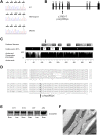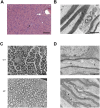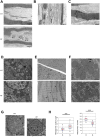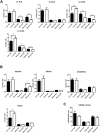Bovine and murine models highlight novel roles for SLC25A46 in mitochondrial dynamics and metabolism, with implications for human and animal health
- PMID: 28376083
- PMCID: PMC5380314
- DOI: 10.1371/journal.pgen.1006597
Bovine and murine models highlight novel roles for SLC25A46 in mitochondrial dynamics and metabolism, with implications for human and animal health
Abstract
Neuropathies are neurodegenerative diseases affecting humans and other mammals. Many genetic causes have been identified so far, including mutations of genes encoding proteins involved in mitochondrial dynamics. Recently, the "Turning calves syndrome", a novel sensorimotor polyneuropathy was described in the French Rouge-des-Prés cattle breed. In the present study, we determined that this hereditary disease resulted from a single nucleotide substitution in SLC25A46, a gene encoding a protein of the mitochondrial carrier family. This mutation caused an apparent damaging amino-acid substitution. To better understand the function of this protein, we knocked out the Slc25a46 gene in a mouse model. This alteration affected not only the nervous system but also altered general metabolism, resulting in premature mortality. Based on optic microscopy examination, electron microscopy and on biochemical, metabolic and proteomic analyses, we showed that the Slc25a46 disruption caused a fusion/fission imbalance and an abnormal mitochondrial architecture that disturbed mitochondrial metabolism. These data extended the range of phenotypes associated with Slc25a46 dysfunction. Moreover, this Slc25a46 knock-out mouse model should be useful to further elucidate the role of SLC25A46 in mitochondrial dynamics.
Conflict of interest statement
The authors have declared that no competing interests exist.
Figures






Similar articles
-
Loss of function of SLC25A46 causes lethal congenital pontocerebellar hypoplasia.Brain. 2016 Nov 1;139(11):2877-2890. doi: 10.1093/brain/aww212. Brain. 2016. PMID: 27543974 Free PMC article.
-
Loss of SLC25A46 causes neurodegeneration by affecting mitochondrial dynamics and energy production in mice.Hum Mol Genet. 2017 Oct 1;26(19):3776-3791. doi: 10.1093/hmg/ddx262. Hum Mol Genet. 2017. PMID: 28934388 Free PMC article.
-
Novel insights into SLC25A46-related pathologies in a genetic mouse model.PLoS Genet. 2017 Apr 4;13(4):e1006656. doi: 10.1371/journal.pgen.1006656. eCollection 2017 Apr. PLoS Genet. 2017. PMID: 28376086 Free PMC article.
-
Mitochondrial Membrane Dynamics and Inherited Optic Neuropathies.In Vivo. 2017 Jul-Aug;31(4):511-525. doi: 10.21873/invivo.11090. In Vivo. 2017. PMID: 28652416 Free PMC article. Review.
-
Mitochondrial dynamics and inherited peripheral nerve diseases.Neurosci Lett. 2015 Jun 2;596:66-77. doi: 10.1016/j.neulet.2015.04.001. Epub 2015 Apr 3. Neurosci Lett. 2015. PMID: 25847151 Review.
Cited by
-
Insights into the genotype-phenotype correlation and molecular function of SLC25A46.Hum Mutat. 2018 Dec;39(12):1995-2007. doi: 10.1002/humu.23639. Epub 2018 Sep 17. Hum Mutat. 2018. PMID: 30178502 Free PMC article.
-
Progressive ataxia of Charolais cattle highlights a role of KIF1C in sustainable myelination.PLoS Genet. 2018 Aug 1;14(8):e1007550. doi: 10.1371/journal.pgen.1007550. eCollection 2018 Aug. PLoS Genet. 2018. PMID: 30067756 Free PMC article.
-
SLC-25A46 regulates mitochondrial fusion through the mitofusin protein FZO-1 and is essential for maintaining neuronal morphology.J Cell Sci. 2025 Jun 15;138(12):jcs263571. doi: 10.1242/jcs.263571. Epub 2025 Jun 23. J Cell Sci. 2025. PMID: 40444356 Free PMC article.
-
Genetic compensation in a stable slc25a46 mutant zebrafish: A case for using F0 CRISPR mutagenesis to study phenotypes caused by inherited disease.PLoS One. 2020 Mar 24;15(3):e0230566. doi: 10.1371/journal.pone.0230566. eCollection 2020. PLoS One. 2020. PMID: 32208444 Free PMC article.
-
Clinicopathological and pedigree investigation of a novel spinocerebellar neurological disease in juvenile Quarter Horses in North America.J Vet Intern Med. 2024 May-Jun;38(3):1808-1814. doi: 10.1111/jvim.17049. Epub 2024 Apr 26. J Vet Intern Med. 2024. PMID: 38669583 Free PMC article.
References
-
- Zick M, Rabl R, Reichert AS. Cristae formation-linking ultrastructure and function of mitochondria. Biochim Biophys Acta—Mol Cell Res [Internet]. Elsevier B.V.; 2009;1793(1):5–19. - PubMed
Publication types
MeSH terms
Substances
LinkOut - more resources
Full Text Sources
Other Literature Sources
Molecular Biology Databases

